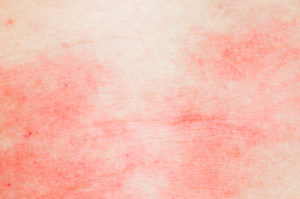 The term eczema is broadly applied to a range of persistent skin conditions. Basically, it is inflammation of the skin. Itchy patches form on the skin and can be widespread or limited to just a few areas. Because they itch, the scratching often associated with them leads to redness, cracking, swelling, drainage of clear fluid, crusting and scaling of the skin.
The term eczema is broadly applied to a range of persistent skin conditions. Basically, it is inflammation of the skin. Itchy patches form on the skin and can be widespread or limited to just a few areas. Because they itch, the scratching often associated with them leads to redness, cracking, swelling, drainage of clear fluid, crusting and scaling of the skin.
There are many different types of eczema.
Atopic Dermatitis
When atopic dermatitis begins during infancy it is known as infantile eczema. Itchy patches form on the scalp, forehead and face – especially on the cheeks. Occasionally, this condition will resolve on its own by the age of two. If it continues into childhood, patches often form on the back of the knees and inside the elbows. 30% of children who develop atopic dermatitis have a family history for asthma, eczema or hay fever/allergic rhinitis. While 70% of children outgrow their eczema by late teenage years to early adulthood, it can continue into adulthood. Teenagers and young adults dealing with atopic dermatitis often have patches on their hands, feet, ankles, wrists, and face but patches can occur anywhere on the body. If it continues into adulthood, fortunately, it tends to become less severe with age.
Allergic Contact Dermatitis
Allergic contact dermatitis is caused by coming into direct contact with a chemical you are allergic to. The irritation causes red, scaly patches to appear. This often occurs on the hands. This type of dermatitis can be difficult to treat because often it requires the person to change their daily hygiene or work habits which may be causing the irritation. Soaps, overexposure to water or other solvents, handling of items with chemicals on them, and other daily activities can cause this type of eczema to worsen. We will sometimes use patch testing (similar to allergy testing) to test for any contact allergies to chemicals.
Nummular Eczema
Nummular Eczema usually presents as scattered “coin-shaped” red scaly patches most commonly on the arms and legs. It can also occur on the trunk. This type of eczema is more common in older patients. It is most common in the colder, winter months and is caused from dry skin. If you have nummular eczema, you should only bathe once a day or every other day with tepid (warm, not hot) water. Hot water makes this condition worse. One should use a moisturizing, gentle cleanser such as Cetaphil Restoraderm or Cerave gentle cleanser during bathing. A thick moisturizing cream such as Cetaphil Restoraderm or Cerave Cream should be applied twice a day to the body. A prescription for a topical steroid ointment may be given to apply directly to the red patches twice a day.
It is not always easy to determine one type of eczema from another. We will sometimes use patch testing (similar to allergy testing) to test for contact allergies to chemicals. In some cases, we may decide to do a biopsy (obtain a small sample) of the area to determine the cause. Treatment often involves applying topical creams or ointments to help relieve itching and inflammation. Antihistamines are also helpful in controlling the itch associated with eczema. Oral Corticosteroids and Cyclosporine may be prescribed to help treat severe eczema that may not have responded to other treatments. Our experienced providers will determine if your condition is eczema and provide the appropriate treatment.


